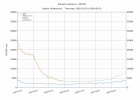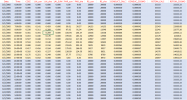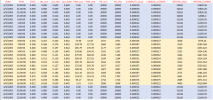Good afternoon.
I'm working on the implementation of the new vegetation approach to NWP model COSMO. As an example of these implementations I'm using the CLM 3.5 model code. I have implemented several modules from CLM 3.5 to the COSMO model including CanopyFluxesMod with subroutine Stomatal and we got the results. However, I think that, our results are strange and I think that they are not correct, especially during winter time and night time. Because of that I have several questions and hope that you can help me:
1) What do you think about my values of stomatal resistance, especially during the winter season (image. 1) and at night time (image 2.)? ( Blue - is night time, yellow - day time (cosz > 0) CONDUCT_CALC and RSTOM_CALC - I got in EXCEL; CONDUCT_COSMO and RSTOM_COSMO - I got from model)
2) What can be the reasons for these values of stomatal resistance? (I'm sure on 95% that all my dimensions are correct and no mistakes in my part of the code).
For canopy conductance I used q_st = ( 1/r_sun ) * L_sun + ( 1/r_sha ) * L_sha
3) How can I fix my values to correct values? (Because as I understand the real values from 100 s/m (stomata open) to 5000 s/m (stomata close).
4) What can I do with low values of LAI from 0.02 to 0.7? What did you do with low numbers of LAI and which stomatal resistance values do you have at night and in winter?
5) Do you have examples of stomatal resistance values for the territory of Germany? Because I can't run CLM3.5 and compare my results with CLN3.5
Additional comments for plot (RSTOM):
1) the blue line is the original COSMO data with stomatal resistance calculations based on Jarvis approach;
2) the orange, green or grey line is my experiments with stomatal resistance calculations based on Ball Berry approach and CLM3.5 code.
Best regards,
Evgenii Churiulin
CESR, Kassel
I'm working on the implementation of the new vegetation approach to NWP model COSMO. As an example of these implementations I'm using the CLM 3.5 model code. I have implemented several modules from CLM 3.5 to the COSMO model including CanopyFluxesMod with subroutine Stomatal and we got the results. However, I think that, our results are strange and I think that they are not correct, especially during winter time and night time. Because of that I have several questions and hope that you can help me:
1) What do you think about my values of stomatal resistance, especially during the winter season (image. 1) and at night time (image 2.)? ( Blue - is night time, yellow - day time (cosz > 0) CONDUCT_CALC and RSTOM_CALC - I got in EXCEL; CONDUCT_COSMO and RSTOM_COSMO - I got from model)
2) What can be the reasons for these values of stomatal resistance? (I'm sure on 95% that all my dimensions are correct and no mistakes in my part of the code).
For canopy conductance I used q_st = ( 1/r_sun ) * L_sun + ( 1/r_sha ) * L_sha
3) How can I fix my values to correct values? (Because as I understand the real values from 100 s/m (stomata open) to 5000 s/m (stomata close).
4) What can I do with low values of LAI from 0.02 to 0.7? What did you do with low numbers of LAI and which stomatal resistance values do you have at night and in winter?
5) Do you have examples of stomatal resistance values for the territory of Germany? Because I can't run CLM3.5 and compare my results with CLN3.5
Additional comments for plot (RSTOM):
1) the blue line is the original COSMO data with stomatal resistance calculations based on Jarvis approach;
2) the orange, green or grey line is my experiments with stomatal resistance calculations based on Ball Berry approach and CLM3.5 code.
Best regards,
Evgenii Churiulin
CESR, Kassel



